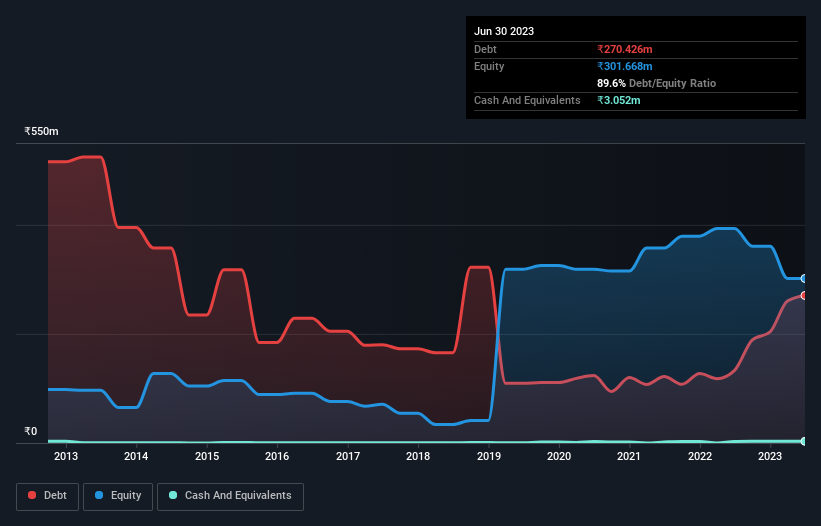We Think LGB Forge (NSE:LGBFORGE) Has A Fair Chunk Of Debt
Some say volatility, rather than debt, is the best way to think about risk as an investor, but Warren Buffett famously said that 'Volatility is far from synonymous with risk.' So it might be obvious that you need to consider debt, when you think about how risky any given stock is, because too much debt can sink a company. Importantly, LGB Forge Limited (NSE:LGBFORGE) does carry debt. But is this debt a concern to shareholders?
When Is Debt Dangerous?
Debt is a tool to help businesses grow, but if a business is incapable of paying off its lenders, then it exists at their mercy. Ultimately, if the company can't fulfill its legal obligations to repay debt, shareholders could walk away with nothing. However, a more frequent (but still costly) occurrence is where a company must issue shares at bargain-basement prices, permanently diluting shareholders, just to shore up its balance sheet. Of course, plenty of companies use debt to fund growth, without any negative consequences. The first thing to do when considering how much debt a business uses is to look at its cash and debt together.
View our latest analysis for LGB Forge
What Is LGB Forge's Net Debt?
The image below, which you can click on for greater detail, shows that at March 2023 LGB Forge had debt of ₹270.4m, up from ₹133.2m in one year. Net debt is about the same, since the it doesn't have much cash.

A Look At LGB Forge's Liabilities
Zooming in on the latest balance sheet data, we can see that LGB Forge had liabilities of ₹511.2m due within 12 months and liabilities of ₹39.1m due beyond that. Offsetting these obligations, it had cash of ₹3.05m as well as receivables valued at ₹356.9m due within 12 months. So it has liabilities totalling ₹190.3m more than its cash and near-term receivables, combined.
Of course, LGB Forge has a market capitalization of ₹2.31b, so these liabilities are probably manageable. But there are sufficient liabilities that we would certainly recommend shareholders continue to monitor the balance sheet, going forward. There's no doubt that we learn most about debt from the balance sheet. But it is LGB Forge's earnings that will influence how the balance sheet holds up in the future. So when considering debt, it's definitely worth looking at the earnings trend. Click here for an interactive snapshot.
In the last year LGB Forge had a loss before interest and tax, and actually shrunk its revenue by 9.8%, to ₹1.2b. That's not what we would hope to see.
Caveat Emptor
Importantly, LGB Forge had an earnings before interest and tax (EBIT) loss over the last year. To be specific the EBIT loss came in at ₹88m. Considering that alongside the liabilities mentioned above does not give us much confidence that company should be using so much debt. Quite frankly we think the balance sheet is far from match-fit, although it could be improved with time. However, it doesn't help that it burned through ₹112m of cash over the last year. So to be blunt we think it is risky. The balance sheet is clearly the area to focus on when you are analysing debt. But ultimately, every company can contain risks that exist outside of the balance sheet. For example LGB Forge has 2 warning signs (and 1 which is concerning) we think you should know about.
If you're interested in investing in businesses that can grow profits without the burden of debt, then check out this free list of growing businesses that have net cash on the balance sheet.
New: AI Stock Screener & Alerts
Our new AI Stock Screener scans the market every day to uncover opportunities.
• Dividend Powerhouses (3%+ Yield)
• Undervalued Small Caps with Insider Buying
• High growth Tech and AI Companies
Or build your own from over 50 metrics.
Have feedback on this article? Concerned about the content? Get in touch with us directly. Alternatively, email editorial-team (at) simplywallst.com.
This article by Simply Wall St is general in nature. We provide commentary based on historical data and analyst forecasts only using an unbiased methodology and our articles are not intended to be financial advice. It does not constitute a recommendation to buy or sell any stock, and does not take account of your objectives, or your financial situation. We aim to bring you long-term focused analysis driven by fundamental data. Note that our analysis may not factor in the latest price-sensitive company announcements or qualitative material. Simply Wall St has no position in any stocks mentioned.
About NSEI:LGBFORGE
LGB Forge
Engages in manufacture and sale of forged and machined components in India.
Adequate balance sheet low.
Similar Companies
Market Insights
Community Narratives




